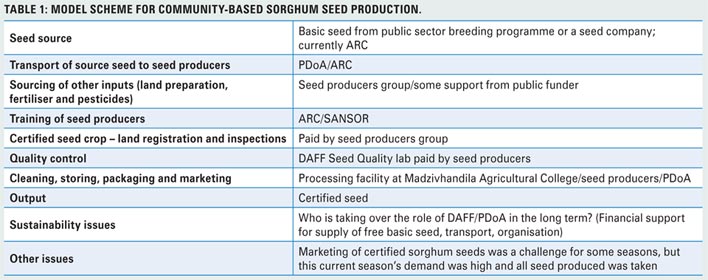March 2015
NEMERA SHARGIE, ARC-Grain Crops Institute
To achieve food security for the poor at household level, smallholder farmers should be supported to increase food production. Smallholder farmers grow food to directly feed their households; if enabled they can create secure livelihoods for large numbers of people in communities that need it the most.
The Limpopo province, where sorghum is mainly produced by smallholder farmers, faces a major challenge in how to improve production and productivity. In addition to varietal improvement and enhanced crop management, use of quality seed significantly contributes to improved productivity of sorghum.
Open-pollinated varieties are used in Limpopo and other parts of South Africa. Training farmers in community-based seed production can have an impact on farmers’ access to seed, provided that seed production costs can be kept lower than those of the formal seed sector and that the quality of the seed produced meets the farmers’ expectations.
The ARC-Grain Crops Institute (ARC-GCI) started a sorghum seed production project with a group of smallholder farmers in the Limpopo province with funding obtained from the Department of Agriculture, Forestry and Fisheries (DAFF). The two projects are the Difahlane project, in Makhuduthamaga municipality, where twelve farmers took part; and the Ka-Dikweneng project, located in Lepelle-Nkumpi municipality where four beneficiaries participated.
These two groups of seed growers produced certified seed of sorghum over the last five years assisted by the ARC-GCI and local extension officers. The standards for seed production have been met and enforced by the South African National Seed Organisation (SANSOR), which controls the seed certification scheme.
When producing seed, a producer usually wants to maintain the characteristics of a variety. Cross-pollination between different sorghum varieties must therefore be prevented. Isolating the seed production field from other sorghum fields helps achieve this. If two different varieties are grown next to each other, cross-pollination will occur between the two varieties and the crop grown from such seed will have unwanted characteristics from the other variety.
Quality control in sorghum seed production
The production and distribution of quality sorghum seed requires diligent efforts both during field production and post-harvest handling. Field inspections are commonly conducted at different crop development stages to ensure quality. The certified seed crop must be inspected at least three times by inspectors affiliated with SANSOR, i.e. during the vegetative growth stage, at flowering and at maturity.
Furthermore, various standard tests for moisture content, germination and physical purity can be conducted to evaluate the quality of the seed. The most common evaluation conducted is germination tests, designed to determine the seed’s capacity to germinate and produce normal plants when sown under favourable conditions.
The model scheme adopted for the community-based seed production was a farmers’ group producing certified seed and catering for the seed demands of neighbouring producers (Table 1).
Training seed producers
 Training courses are offered to individuals in the respective groups. Sometimes field days are conducted to improve awareness of the improved cultivars available and illustrate important aspects of seed production (field selection, planting pattern, weeding and fertiliser rates, and plant protection).
Training courses are offered to individuals in the respective groups. Sometimes field days are conducted to improve awareness of the improved cultivars available and illustrate important aspects of seed production (field selection, planting pattern, weeding and fertiliser rates, and plant protection).
Strong partnerships should be established between community-based farmers’ groups/seed producers, extension officers from DAFF, the municipality and district administration and NGOs to promote the use of quality seeds on smallholder farms at municipality and district level.
Publication: March 2015
Section: Focus on


















